
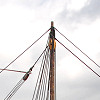

Sea Stallion of Glendalough
Reconstruction of the warship Skuldelev, the remains of which is on display in the museum (building left background of photo with the red banners in front).
With a top speed of some 12 knots (≈22km/hour) and carrying 60-70 warriors, this was an impressive longboat, which reached far away destinations.
This photo is by now historic. The vessel will be hauled ashore and placed in a separate exhibition and thus no longer be seen in its natural element.


The Viking Museum in the city of Roskilde comes in two parts.
Pictured is the exhibition building inside of which are the remains of the old viking vessels found at Skuldelev in Roskilde Fjord.
The other section contains a number of reconstructed life-size viking vessels, exhibition of vessel building techniques of the nordic countries, and actual shipbuilding of wooden vessels.


The harbor section of the Viking Museum.
Old nordic vessels are constructed in the hall on the wooden on the right and the hall on the right houses a small cafeteria and gift shop.
Many small booths and displays in the areas around the two halls explain in many languages interesting details about old nordic vessels and ship building.
On many days there are special exhibits and live demonstrations of coinage, blacksmith work, etc.

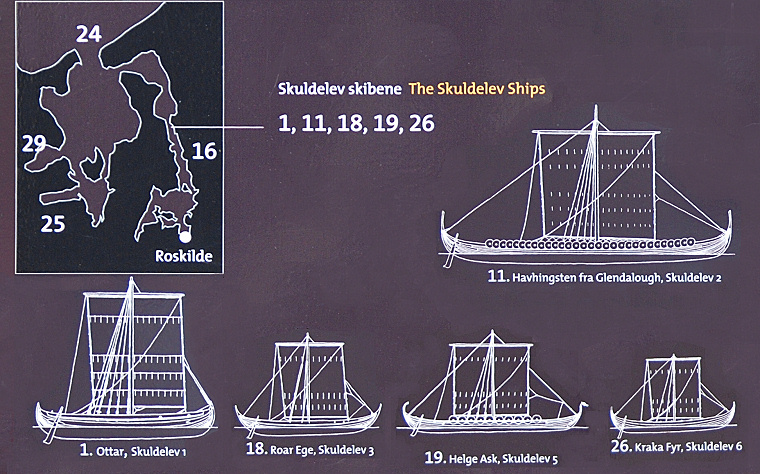
These are artistic outlines of the vessels excavated in 1962 at Skuldelev, which are exhibited in the museum.
Replicas of all of these are on display in the harbor of the museum.


This is how the vessels lay when they were discovered.
But why were they there, in the first place?
The vessels had clearly been scuttled in a way that blocked sea born access to the lower part of the fjord.
Apparently, the locals were expecting an imminent attack from the sea and decided to sacrifice some of their precious vessels for defensive purposes.


The five vessels in the exhibition hall.
In front, the large ocean going trader with the large longboat behind her, on the same side of the low, center wall.
On the left, the small trading vessel and behind her, at the far left, the small longboat.
The fishing vessel is barely visible on the far right of the photo.
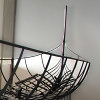

Great Longship
This mighty, ocean-going viking warship was an awesome vessel and not a sight that any enemy would like to see.
This particular ship was built in Ireland in year 1042, some 2-300 years after the first vikings settled in Ireland.
It carried about 65-70 viking warriors and had a similar number of oars.
Top speed under wind power was an impressive 12 knots or about 22 km/hour.
The great longship reached far away destinations like North America (way before Columbus!), the entire Mediterranean coast, the Caspian Sea and the full length of River Volga.
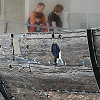

Small longship constructed around year 1030.
A small warship most suited to roam the coastal waters.
With some 30 viking warriors, it was a small support vessel, which however could manage a top speed of some 14 knots (25 km/hour).
See also the full size reconstruction on next photo.
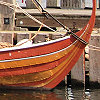

Small longship - Helge Ask
A small warship most likely used for defensive- and support roles in coastal waters.
It had 13 oars on each side and carried a crew of 30 viking warriors.
It is 17.5 meters long and 2.5 meters wide. Its draught was a mere 0.55 meter and the sail area was a relatively impressive 46 m².
This is a full-size reconstruction of a similar vessel exhibited in the museum. Top speed was about 14 knots (25 km/hour) with favorable winds.
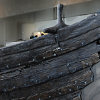

Coastal trader
This is a small coastal trading and transport vessel.
It can load some 4 tons of cargo and would have a crew of 5-8 sailors.
A full-size reconstruction built in the workshop of the museum achieved respectable speeds of 8-9 knots (14-17 km/hour) on wind power.
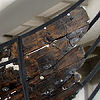

Ocean trader
This vessel is an ocean-going trading and transportation vessel, which was capable of roaming the Baltic, the North Sea or even the Atlantic.
The vessel was originally constructed around year 1030 with pine planks in Western Norway and was later repaired with oak in Norway and Denmark.
It had a crew of 6-8 sailors and with top speeds of 10-14 knots (18-25 km/hour) on wind power, it could almost outrun a longship.
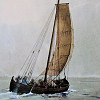

Ocean trader
Artistic rendering of what an ocean-going trading vessel would look like (source: Viking Museum).
The vessel is 16 meters long and almost 5 meters wide. It has a draught of 1 meter.
The sail area was about 90 m², which with its relative small body size gave it an impressive top speed of up to 14 knots (25 km/hour).


Small fishing vessel
Built in Norway of pine, she was most likely used for fishing, whaling or seal hunting.
An additional side plank was later added, making the boat better suited for passenger and goods carriage.
She was 12 meters long and 2.5 meters wide. She had a draught of 0.5 meter and carried a sail of 25m² giving a top speed under sail of about 12.5 knots.
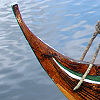

Fishing vessel - Kraka Fyr
Replica of the fishing vessel in the exhibition hall (previous picture).
Built in the workshop of the museum in 1998, the vessel originally carried a crew of some 15 fishermen pulling 14 oars.
She was later remodeled into a freight vessel now with a crew of some 5-6 and with only 4 oars.
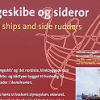

The harbor area of the museum has a wealth of explanatory displays on older vessels.
These two displays cover the topic of the rudder.
The earlier side rudder was gradually replaced in the Middle Ages by a stern rudder.
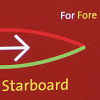

If you ever wondered why sailors use the word "starboard" for what we landlubbers call "right" side, then here is the explanation.
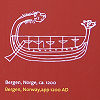

The displays come with great illustrations.
Here are outlines of vessels with side rudders from three different eras.


If you ever doubted that vikings were marauding their neighbors, then study the pictures on this stone, chiseled in Gotland in the 10th century.


Passenger comfort was not exactly in focus in the construction.
In fact, sea trials with this life-sized replica showed that it was quite difficult to row the vessel with all 60+ crew members at the oars at the same time.
The warriors had little protection against the elements, which often could be quite inclement on a journey across the Atlantic.
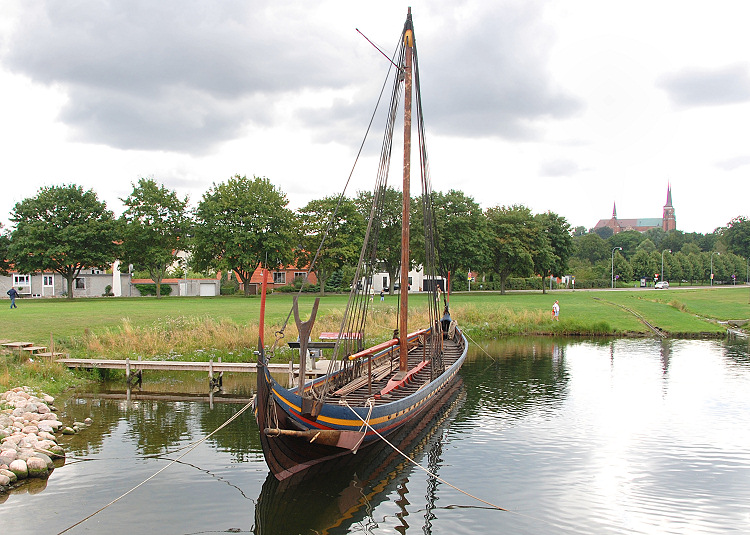

A longship was a formidable vessel for its time.
This picture gives a good impression of the relative large size.
It may be dwarfed by today's cruise ships and container vessels, but back in the 9-11th century, this was one of the largest ocean going warships around.


How do we know that the longship exhibited in the museum was built in year 1042 ?
More precisely, we even know that it was built during the summer of year 1042 !
Simple, you count the rings in the wood.


Not all species of wood last equally long.
Here you can see the permanence of various species of wood depending upon the conditions under which it is kept.
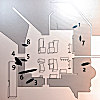

Back to viking ships.
As if the discovery of the Skuldelev vessels was not enough then, incredibly, during the excavation of the harbor of the museum another nine vessels were discovered, buried deep in the silt.
On this drawing, the "road" right is the bridge, which connects the museum harbor with the main museum building (outside the drawing to the right).
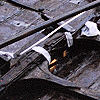

The Roskilde discovery covered a wide range of vessel types.
Particularly, vessel numbered Roskilde 6 set a world record, being the longest viking longboat ever discovered.
36 meters long it had 78 oars and accommodated a total number of about 100 warriors.
Built after year 1025, it was 3.5 meters wide, had a draught of one meter and boasted a sail area of some 300m².
Note how the keel stretches all the way to the far right end of the photo.
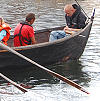

If you feel like a viking after touring the exhibition, then you have an excellent opportunity to live out part of that fantasy.
You can become a slave, be commanded to grab an oar and apply your rowing skills to power a viking vessel replica into the fjord -never to be seen again!
In the wooden building with the slanted roof (and in its twin just out of the picture left) volunteer craftsmen are constructing replicas of old viking vessels.
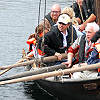

It may look easy, but it actually takes quite some practice to maneuver a viking vessel.
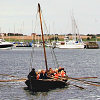

And with a last look at the viking vessel heading out to sea to raid foreign remote lands we say goodbye to the Viking museum at Roskilde.
A venue worth a visit for children and adults alike.





